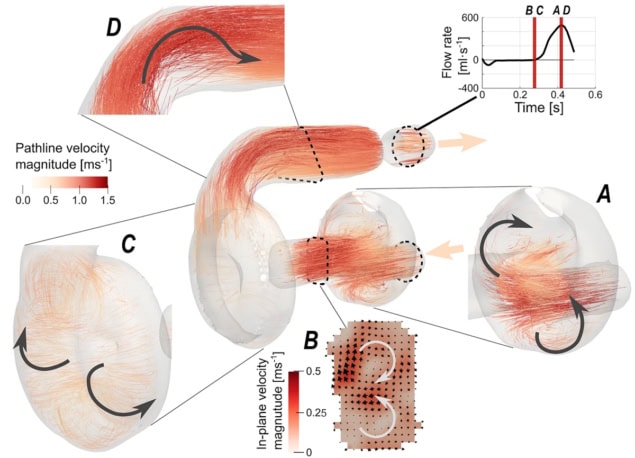Researchers visualize blood flow in pulsating artificial heart
A research team in Sweden has used real-time imaging technology to visualize the way that blood pumps around a pulsating artificial heart – moving medicine one step closer to the safe use of such devices in people waiting for donor transplants.
The Linköping University (LiU) team used 4D flow MRI to examine the internal processes of a mechanical heart prototype created by Västerås-based technology company Scandinavian Real Heart. The researchers evaluated blood flow patterns and compared them with similar measurements taken in a native human heart, outlining their results in Scientific Reports.
“As the pulsatile total artificial heart contains metal parts, like the motor, we used 3D printing [to replace most metal parts] and a physiological flow loop so we could run it in the MRI scanner under representable conditions,” says first author Twan Bakker, a PhD student at the Center for Medical Image Science and Visualization at LiU.
No elevated risk
According to Bakker, this is first time that a 3D-printed MRI-compatible artificial heart has been built and successfully evaluated using 4D flow MRI. The team was pleased to discover that the results corroborate the findings of previous computational fluid dynamics simulations indicating “low shear stress and low stagnation”. Overall flow patterns also suggest there is no elevated risk for blood complications compared with hearts in healthy humans and those suffering from valvular disease.
“[The] patterns of low blood flow, a risk for thrombosis, were in the same range as for healthy native human hearts. Patterns of turbulent flow, a risk for activation of blood platelets, which can contribute to thrombosis, were lower than those found in patients with valvular disease,” says Bakker.
“4D flow MRI allows us to measure the flow field without altering the function of the total artificial heart, which is therefore a valuable tool to complement computer simulations and blood testing during the development of the device. Our measurements provided valuable information to the design team that could improve the artificial heart prototype further,” he adds.
Improved diagnostics
A key advantage of 4D flow MRI over alternative measurement techniques – such as particle image velocimetry and laser doppler anemometry – is that it doesn’t require the creation of a fully transparent model. This is an important distinction for Bakker, since some components in the artificial heart are made with materials possessing unique mechanical properties, meaning that replication in a see-through version would be extremely challenging.

“With 4D flow MRI we had to move the motor away from the scanner bore, but the material in contact with the blood and the motion of the device remained as the original design,” says Bakker.
According to Bakker, the velocity measurements can also be used for visualization and analysis of hemodynamic parameters, such as turbulent kinetic energy, wall shear stresses and more in the heart, as well as for larger vessels in our bodies.
“By studying the flow dynamics in patients and healthy subjects, we can better understand its role in health and disease, which can then support improved diagnostics, interventions and surgical therapies,” he explains.
Moving forward, Bakker says that the research team will continue to evaluate the improved heart design, which was recently granted designation as a Humanitarian Use Device (HUD) by the US Food and Drug Administration (FDA).
“This makes it possible to apply for designation as a Humanitarian Device Exemption (HDE) – which may grant the device limited marketing rights and paves the way for the pre-clinical and clinical studies,” he says.
“In addition, we are currently developing tools to compute blood flow using simulations. This may provide us with a deeper understanding of the mechanisms that cause the formation of thrombosis and haemolysis,” he tells Physics World.
The post Researchers visualize blood flow in pulsating artificial heart appeared first on Physics World.